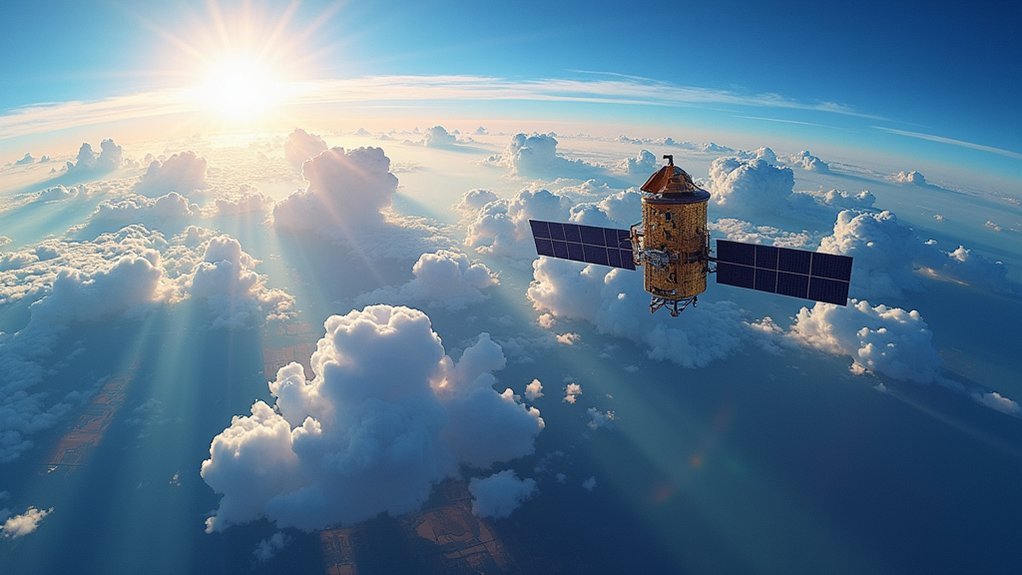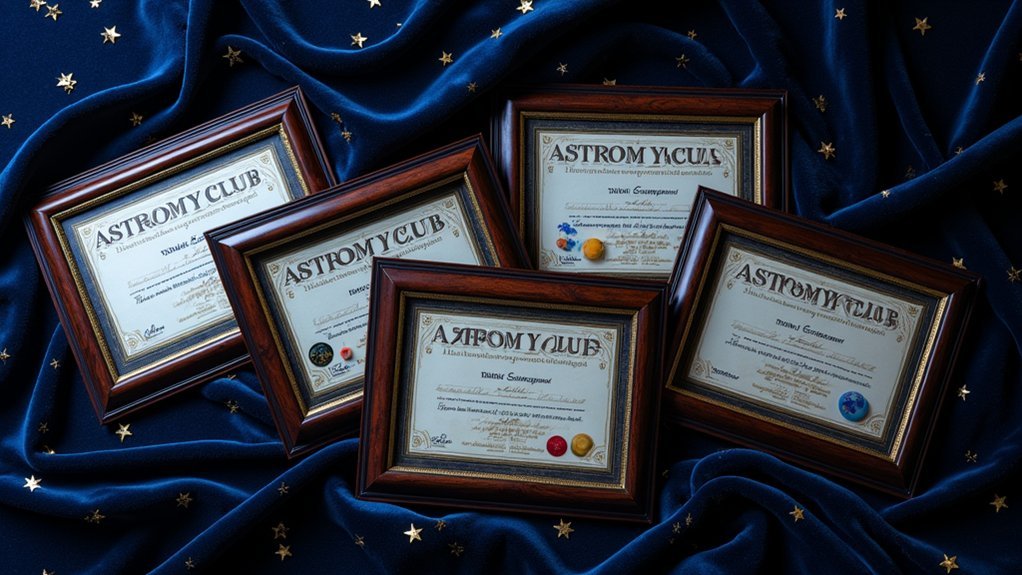Orbital mechanics impacts your daily life more than you realize. When you check weather forecasts, navigate with GPS, send text messages, watch satellite TV, or stream videos online, you’re relying on precisely positioned satellites. These spacecraft follow Kepler’s laws as they orbit Earth at specific altitudes and velocities. Even the International Space Station‘s microgravity environment, circling Earth every 90 minutes, enables scientific discoveries that benefit your everyday technologies and medical treatments. The universe’s fundamental physics shapes modern conveniences in surprising ways.
6 Second-Level Headings for “Real-World Examples: Orbital Mechanics in Everyday Life”

While orbital mechanics might seem like an abstract concept confined to physics textbooks, it actually permeates our everyday experiences through various technologies we rely on constantly. Your GPS navigation, weather reports, satellite TV, and internet connections all depend on precise orbital mechanics.
Orbital mechanics isn’t just theoretical—it powers the navigation, communications, and information systems you use every day.
The most relevant examples include communication satellites in geostationary orbit that provide your internet service, weather forecasting systems that track storms from fixed positions above Earth, and GPS satellites that pinpoint your location by maintaining specific orbital periods.
Earth observation satellites in Low Earth Orbit (LEO) like Hubble capture detailed images without atmospheric interference. Even space exploration missions rely on calculated trajectories that use planetary gravitational pull for efficient travel.
Without these applications of orbital mechanics, many technologies you depend on daily would simply cease to function.
GPS Navigation Systems: How Satellite Orbits Guide Your Daily Commute
How often do you check your phone for directions without considering the complex orbital mechanics making it possible? Your GPS relies on satellites circling in Medium Earth Orbit (MEO), approximately 20,200 kilometers above Earth’s surface.
These GPS satellites follow paths dictated by Kepler’s laws, maintaining precise orbital trajectories that guarantee consistent coverage worldwide.
When you navigate, each satellite broadcasts its position and exact time. Your device receives these signals, measures tiny differences in arrival times (accounting for signal delays through the atmosphere), and uses this data to triangulate your location.
For peak accuracy, your phone needs signals from at least four satellites.
This orbital dance of satellites isn’t just guiding your daily commute—it’s powering mapping systems, surveying tools, and network synchronization as they circle between you and the sun.
Weather Forecasting: The Role of Earth-Observing Satellites in Predicting Tomorrow’s Weather

The next time you check tomorrow’s forecast, consider that the same orbital principles guiding your GPS are also powering our weather prediction systems.
Earth-observing satellites, particularly those in geostationary orbits like NOAA’s GOES series, maintain fixed positions relative to our planet through precise orbital motion.
These strategic satellite deployments allow meteorologists to continuously monitor specific regions, tracking storm development and atmospheric conditions in real-time.
Strategic satellite positioning gives meteorologists the power to watch our atmosphere unfold like a continuous weather story.
As you plan outdoor activities, remember that accurate weather predictions rely on these satellites’ constant stream of data on cloud formations, temperature, and humidity levels.
This real-time data feeds into numerical weather prediction models, greatly enhancing forecast reliability.
Thanks to these orbiting observers, we’ve extended our forecasting capabilities from mere hours to 7-10 days in advance, giving you more time to prepare for whatever weather tomorrow brings.
Telecommunications: From Text Messages to Streaming Services via Orbital Networks
Every time you send a text message or stream your favorite show, you’re tapping into a vast network of satellites strategically positioned in Earth’s orbit. The key to this seamless connectivity is Geostationary Orbit (GEO), where communication satellites hover 35,786 kilometers above Earth’s equator.
When a satellite is launched into GEO, engineers use precise mathematical calculations to guarantee it matches Earth’s rotation. This orbital inclination allows it to maintain a fixed position relative to you on the ground.
The 6,905+ active satellites utilize transponders to relay multiple signals simultaneously, enabling real-time communication across continents.
Today’s space technology has revolutionized telecommunications, with satellites serving as invisible bridges for your daily digital interactions—whether you’re video calling family or accessing broadband in remote areas.
The International Space Station: Living and Working in Perpetual Free Fall

Soaring hundreds of kilometers above Earth’s surface, the International Space Station represents humanity’s most ambitious orbital habitat where astronauts live and work in a state of continuous free fall.
This massive human-made structure orbits around our planet at 28,000 kilometers per hour, completing a full circuit every 90 minutes.
You’d experience 16 sunrises and sunsets daily aboard the ISS, dramatically affecting your circadian rhythms.
In this microgravity environment, created by perpetual free fall at 400 kilometers altitude, scientific experiments impossible on Earth become routine.
The station’s low Earth orbit position makes it an ideal laboratory for international collaboration.
Powered by solar panels generating 110 kilowatts, the 420,000-kilogram facility sustains life support systems and equipment that enable astronauts to conduct their groundbreaking research while orbiting Earth every 90 minutes.
Satellite Television and Internet: Bringing Entertainment Through Precise Orbital Calculations
When you change the channel on your satellite TV or send an email through satellite internet, your seemingly simple action relies on an intricate dance of orbital mechanics happening 35,786 kilometers above Earth’s equator.
Geostationary satellites placed at this specific altitude orbit at exactly the same speed as Earth rotates, maintaining continuous coverage for entertainment and communication services.
Synchronized with Earth’s rotation, geostationary satellites hover silently overhead, ensuring your favorite shows stream without interruption.
The remarkable orbital calculations behind your at-home entertainment include:
- Just three strategically positioned satellites can provide near-global coverage
- Transponders on each satellite receive, amplify, and retransmit signals back to your home
- Precise satellite constellations like Starlink maintain low-latency global internet access
Signal transmission from these satellites guarantees you enjoy uninterrupted entertainment with minimal lag, demonstrating how advanced orbital mechanics directly impacts your daily life.
Frequently Asked Questions
What Is Orbital Motion in Real Life Examples?
You see orbital motion in your GPS navigation, weather forecasts, satellite TV, space telescopes like Hubble, and global communications. These technologies rely on satellites following precise paths around Earth.
What Are the Applications of Orbital Mechanics?
You’ll find orbital mechanics powering GPS navigation, weather forecasting, space telescopes, exploration missions, and satellite communications. These applications enable your daily technology while allowing scientists to study distant worlds and monitor Earth.
What Is an Example of Orbit in Real Life?
When you use GPS navigation, you’re relying on satellites in specific orbits that precisely maintain their positions to triangulate your location and help you navigate to your destination with accuracy.
What Are Examples of Things That Orbit?
You’ll find many things orbiting in our universe: Earth’s moon, artificial satellites, planets around the sun, electrons around atomic nuclei, and moons circling other planets in our solar system.
In Summary
You’re surrounded by orbital mechanics in your daily life, from checking weather forecasts to guiding with GPS. When you stream videos, send texts, or watch satellite TV, you’re benefiting from precisely calculated orbits. Even as you read this, astronauts on the ISS are living in perpetual orbit above you. Orbital mechanics isn’t just rocket science—it’s woven into your modern existence.





Leave a Reply